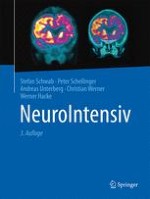Zusammenfassung
Die respiratorische Insuffizienz, d. h. das Unvermögen des Atmungssystems, eine ausreichende Oxygenierung des Blutes und/oder eine adäquate CO2-Elimination zu gewährleisten, gehört zu den häufigsten Todesursachen von Patienten mit Erkrankungen des Nervensystems. Bei Patienten mit akut auftretender respiratorischer Insuffizienz ist die schnelle Beurteilung von höchster Priorität. Das geschädigte Gehirn hat eine besonders schlechte Hypoxietoleranz. Bei unzureichender Oxygenation muss unmittelbar mit Therapiemaßnahmen begonnen werden. Dies bedingt die entsprechende Infrastruktur mit Anästhesiefachwissen vor Ort, auf der Neurointensivstation. Muss ein Patient über einen längeren Zeitraum beatmet werden, so kann die Indikation einer Tracheotomie gegeben sein. Ein außerordentlich häufiges und Outcome-relevantes Symptom in der Intensivmedizin sind auch die Schluckstörungen, auf die sodann eingegangen wird. Schließlich geht es noch um die Anlage eines zentralen Venenkatheters in das Einstromgebiet der Hohlvene, wodurch die Verabreichung von Medikamenten, die parenterale Ernährung, die Messung des zentralen Venendrucks und die Analyse venöser Blutgaswerte ermöglicht wird.











